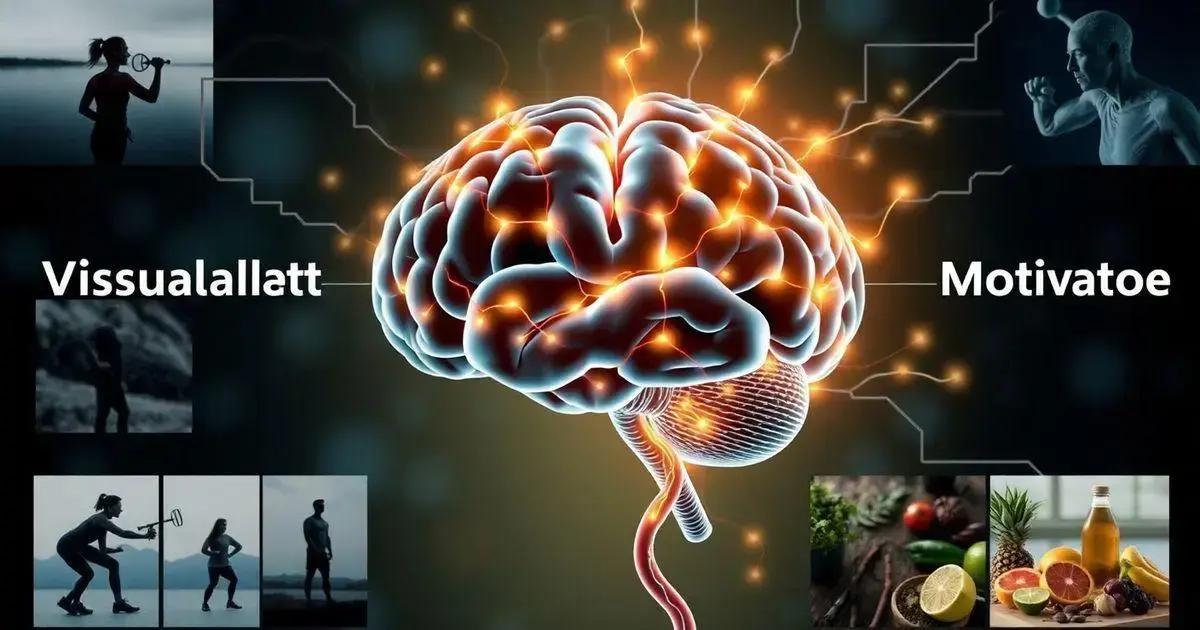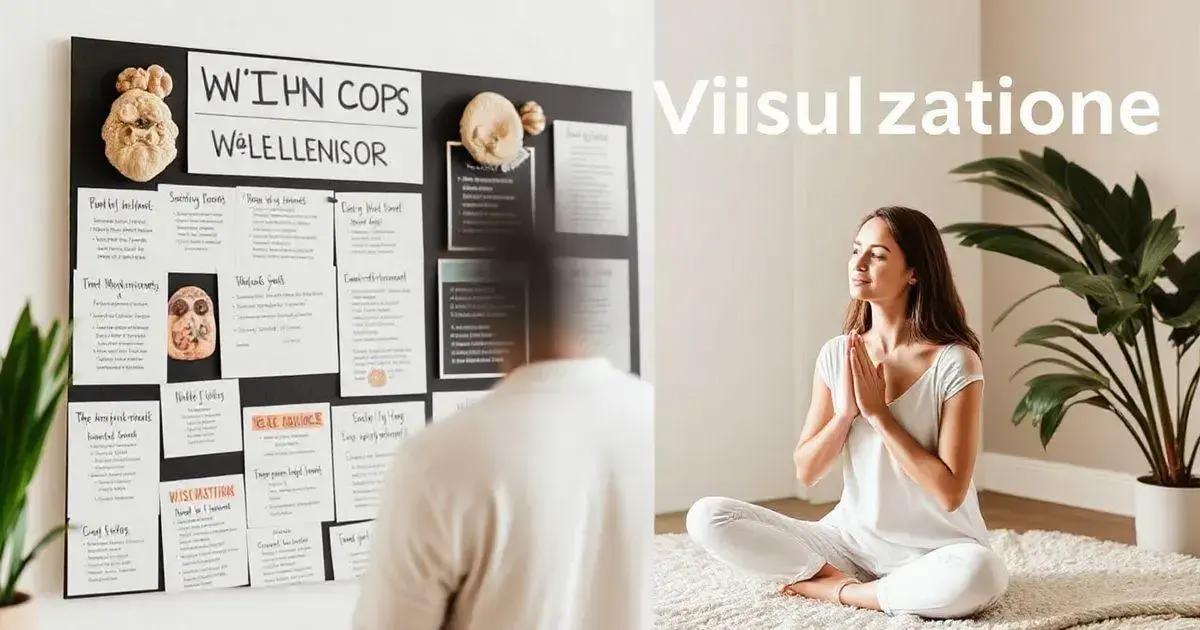Visualization is a powerful technique that can help you stick to your wellness goals by enhancing motivation, focus, and emotional connections to your objectives. By implementing various visualization methods, tracking progress, and regularly practicing this technique, you can effectively achieve your desired outcomes in health and wellness.
Visualization is a powerful tool for achieving wellness goals. By picturing your desired outcome, you can enhance motivation and imagination. Incorporating visualization into your daily routine creates a roadmap for success, making your wellness journey more achievable. In this article, we’ll discuss understanding visualization techniques, the psychology behind them, practical steps to integrate them into your life, and how to effectively track your progress.
Understanding Visualization Techniques

Visualization techniques are methods used to create mental images that help you reach your wellness goals. These techniques involve picturing your desired outcomes vividly, making them more tangible in your mind. By practicing visualization, you can enhance your focus, motivation, and overall performance in various areas, particularly health and wellness.
Types of Visualization Techniques
There are several effective visualization techniques you can employ:
- Guided Visualization: In this method, you listen to a narrator who guides you through a series of images related to your goals. This relaxation technique enables you to form clear mental pictures while calming your mind.
- Creative Visualization: This technique encourages you to imagine your success in achieving wellness goals. You create a detailed mental movie of your desired reality, focusing on every aspect.
- Vision Boards: A vision board is a physical representation of your goals. By collecting images, quotes, and symbols that represent your wellness aspirations, you create a visual reminder of what you’re working towards.
- Affirmations with Visualization: Pairing positive affirmations with visualization can enhance the effectiveness of both. You say positive statements about your wellness journey while visualizing them as your reality.
Benefits of Visualization
Visualization techniques can be beneficial in multiple ways:
- Increased Self-Confidence: Visualizing your success boosts your confidence and helps you believe in your ability to achieve your goals.
- Enhanced Focus: Regular practice teaches your mind to concentrate on your objectives, reducing distractions and obstacles.
- Emotional Regulation: Visualization can help you manage feelings related to stress, anxiety, or discouragement, creating a positive emotional state.
- Improved Performance: Many athletes use visualization to enhance their performance. The same principles can apply to your wellness journey.
Incorporating these visualization techniques into your daily routine can help you stick to your wellness goals by making them feel more achievable and engaging your mind fully in the process.
The Psychology Behind Visualization

The psychology behind visualization is fascinating and plays a key role in achieving wellness goals. Visualization works by tapping into your mind’s ability to create images and emotions related to your desired outcomes. By using this technique, you can influence your mind and body positively.
How the Brain Processes Visualization
When you visualize your goals, your brain doesn’t differentiate between real experiences and imagined ones. This means that if you picture yourself achieving your goals, it can create similar brain activity as if you were actually doing it. This process helps build neural pathways that support your desired actions.
Impact on Motivation and Behavior
Visualization can enhance motivation levels. When you see your goals vividly, it reinforces the belief that you can achieve them, pushing you to take action. This links your mental images to emotional responses, increasing your commitment to your wellness journey.
Overcoming Challenges with Visualization
Many people face obstacles on their path to wellness, such as negative thoughts or self-doubt. Visualization helps counter these feelings. By imagining positive outcomes, you can reduce anxiety and fear. This practice allows you to focus your mind on success rather than barriers.
The Role of Positive Reinforcement
Using visualization can also serve as a form of positive reinforcement. Each time you visualize success, your brain releases dopamine, a chemical that makes you feel good. This process encourages you to repeat the behaviors that lead to your goals, forming positive habits over time.
Practical Steps to Implement Visualization

Implementing visualization into your daily routine can significantly boost your chances of achieving your wellness goals. Here are some practical steps to integrate this powerful technique:
1. Set Clear Wellness Goals
First, start by defining your specific wellness goals. Whether it’s losing weight, increasing fitness levels, or improving mental health, having clear objectives will help you visualize them effectively. Write down these goals to solidify them in your mind.
2. Create a Daily Visualization Routine
Dedicate a few minutes each day to practice visualization. Find a quiet space where you can relax without distractions. Close your eyes and take deep breaths to calm your mind. Then, vividly picture yourself achieving your wellness goals. Focus on how it feels, what you see, and the sounds around you.
3. Use Vision Boards
A vision board is an excellent tool for visualization. Gather images, quotes, and symbols that represent your wellness goals and arrange them on a board. Place this board somewhere you’ll see it daily to remind yourself of your aspirations. This constant visual reminder helps keep your goals at the forefront of your mind.
4. Incorporate Affirmations
Pair your visualization with positive affirmations. As you visualize, repeat uplifting statements that reinforce your goals, such as, “I am healthy and full of energy.” This combination enhances the impact of your practice, making your goals feel more attainable.
5. Reflect and Adjust
Take time each week to reflect on your progress. Consider how your visualization practice is affecting your motivation and actions. If necessary, adjust your goals or visualization techniques to align better with your evolving wellness journey.
Tracking Progress with Visualization
![]()
Tracking your progress is essential when using visualization to meet your wellness goals. By monitoring your achievements, you can stay motivated and make necessary adjustments. Here are some effective ways to track your progress through visualization:
1. Keep a Journal
Start a wellness journal to document your daily visualization practices and any progress you make. Write about your feelings, experiences, and changes in your mindset. This journal becomes a valuable resource for reflecting on your growth over time and helps to reinforce your commitment.
2. Set Milestones
Create specific milestones to track your progress. Break your larger wellness goals into smaller, manageable tasks. For example, if your goal is to lose weight, set weekly targets. Celebrate when you reach these milestones by visualizing your achievements, reinforcing the positive feelings associated with your progress.
3. Use Visual Progress Charts
Implement visual charts or graphs to track your progress over time. Use colors, drawings, or images that resonate with your wellness goals. Seeing your progress visually can enhance motivation and keep you focused on your objectives.
4. Regular Visualization Check-ins
Schedule regular check-ins with yourself, maybe weekly or monthly. During these sessions, visualize where you are compared to where you want to be. Reflect on what you’ve accomplished and how visualization has played a role in your progress.
5. Adjust Your Goals as Needed
As you track your progress, be open to adjusting your goals if necessary. Life can bring unexpected challenges or new opportunities. If your initial goals feel unattainable, use visualization to imagine setting new, realistic goals that excite you and align with your current situation.
Putting Visualization Into Practice for Your Wellness Journey
Using visualization techniques can significantly enhance your ability to stick to your wellness goals. By understanding the psychological principles behind visualization, you can effectively integrate it into your daily routine.
Practical steps, such as setting clear goals, creating vision boards, and tracking your progress, help maintain motivation and focus on your wellness journey. Regular practice and reflection allow you to adapt your visualization techniques as needed, making your goals feel more achievable over time.
Incorporating these visualization strategies can foster a positive mindset and empower you to make lasting changes. Embrace the power of visualization and watch as it transforms not just your goals, but your entire approach to wellness.
FAQ – Frequently Asked Questions about Visualization for Wellness Goals
What is visualization and how does it help with wellness goals?
Visualization is a mental technique that involves picturing your goals and desired outcomes. It helps improve focus and motivation, making your wellness goals feel more achievable.
How can I start practicing visualization?
To begin practicing visualization, find a quiet place, set clear goals, and dedicate a few minutes each day to vividly imagine achieving those goals.
What are some effective visualization techniques?
Some effective techniques include guided visualization, creating vision boards, and pairing visualization with positive affirmations.
How can tracking progress enhance my visualization practice?
Tracking progress allows you to see the results of your visualization efforts, reinforces your commitment, and helps you make necessary adjustments to stay on track.
Can visualization improve my motivation?
Yes, visualization enhances motivation by reinforcing your belief in your goals and creating positive emotional connections to your desired outcomes.
How often should I practice visualization?
It is beneficial to practice visualization daily, even for just a few minutes, to keep your goals fresh in your mind and maintain motivation.













